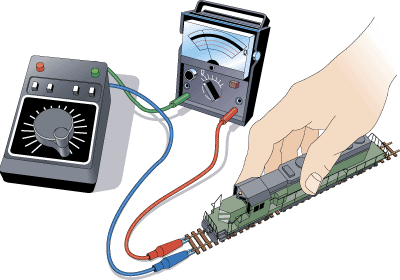Stall Current
Summary: Stall Current is the amperage drawn by a motor when its armature is prevented from rotating. The stall current should be less than the limit of the multifunction decoder.
|
See the Video. |
Stall Current is the current an electrical motor draws when its shaft is prevented from moving. This is typically the highest current a motor will draw. The stall current of a locomotive should be less than the peak current capacity of the decoder that is fitted. If more than the rated current of the decoder, should the mechanism bind or jam, the decoder will be destroyed by the excessive current.
This is of particular importance when converting models manufactured before the turn of the century. Many had motors which have excessive current draws compared to more recent models.
Theory
When a motor is operating, the armature is spinning in a magnetic field. This creates eddy currents in the armature. These eddy currents oppose the flow of current in the winding. More powerful magnets create stronger eddy currents, which limits the speed and current draw of the motor.
If the motor's shaft is prevented from turning, no eddy currents are created (the armature must be moving in the magnetic field). The only limit to the current flow is the Series Resistance of the windings in the motor, so the current will increase.
This can be demonstrated using an ammeter and lamp in series with the motor. While spinning the ammeter will indicate current flow and the lamp will glow. Grab the shaft and prevent the armature from spinning, you will see the current has increased by the indication on the ammeter and the brightness of the lamp. Take note that when power is applied to the motor, there is a surge in current which decreases as the Back EMF increases.[1]
These eddy currents create the Back Electromotive Force (BEMF) used by the decoder to monitor speed and load.
For more information, please see the Back EMF article.
Do You Know How to Test Stall Current?
- ↑ This phenomenon can be seen at home when a motor starts, the lights may dim for a short period of time due to a voltage sag resulting from the current surge.
